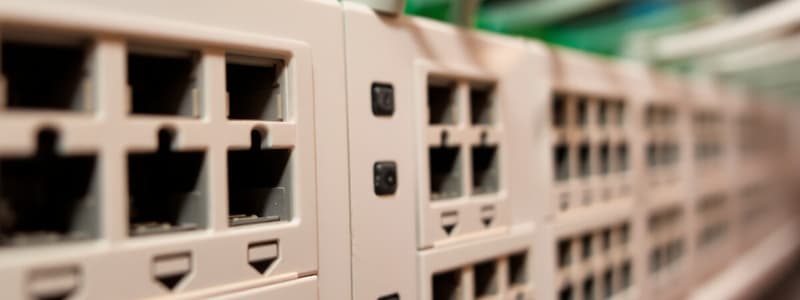Podcast
Questions and Answers
What is the primary function of the Address Resolution Protocol (ARP)?
What is the primary function of the Address Resolution Protocol (ARP)?
- To manage IP address assignments within a network
- To translate IP addresses into physical MAC addresses (correct)
- To encrypt packets sent over a network
- To provide routing information between different networks
What does Neighbor Discovery (ND) use to resolve MAC addresses associated with IPv6 addresses?
What does Neighbor Discovery (ND) use to resolve MAC addresses associated with IPv6 addresses?
- ARP requests and replies
- Direct multicast communication
- ICMPv6 Neighbor Solicitation and Advertisement messages (correct)
- DHCP for address resolution
If an IP address is not found in the ARP table, what action does a device perform?
If an IP address is not found in the ARP table, what action does a device perform?
- It sends an ARP request to broadcast on the network (correct)
- It pauses communication until the MAC address is manually added
- It drops the packet and sends an error message
- It automatically assigns a new IP address to the device
Which of the following is a benefit of using ARP in a network?
Which of the following is a benefit of using ARP in a network?
In what scenario can ARP entries become invalid?
In what scenario can ARP entries become invalid?
What vulnerabilities are associated with ARP?
What vulnerabilities are associated with ARP?
Which protocol is primarily used for address resolution in IPv6 networks?
Which protocol is primarily used for address resolution in IPv6 networks?
What happens when a device receives an ARP request?
What happens when a device receives an ARP request?
What communication method does ND use to send Neighbor Solicitation messages?
What communication method does ND use to send Neighbor Solicitation messages?
What is the purpose of Router Solicitation and Advertisement messages in Neighbor Discovery?
What is the purpose of Router Solicitation and Advertisement messages in Neighbor Discovery?
Flashcards
What is ARP?
What is ARP?
The Address Resolution Protocol (ARP) translates IP addresses into MAC addresses for communication on the same local network.
What are MAC addresses?
What are MAC addresses?
MAC addresses are unique physical addresses used for communication between devices on the same Ethernet network.
What are IP addresses?
What are IP addresses?
IP addresses are used for communication between devices on different networks.
What is the ARP table?
What is the ARP table?
Signup and view all the flashcards
How does ARP work?
How does ARP work?
Signup and view all the flashcards
Are ARP entries permanent?
Are ARP entries permanent?
Signup and view all the flashcards
What is Neighbor Discovery (ND)?
What is Neighbor Discovery (ND)?
Signup and view all the flashcards
How does ND resolve MAC addresses?
How does ND resolve MAC addresses?
Signup and view all the flashcards
How does ND discover routers?
How does ND discover routers?
Signup and view all the flashcards
What are some ARP vulnerabilities?
What are some ARP vulnerabilities?
Signup and view all the flashcards
Study Notes
Address Resolution Protocol (ARP) and Neighbor Discovery
- ARP and Neighbor Discovery enable communication on a network by translating logical addresses (IP addresses) to physical addresses (MAC addresses)
- MAC addresses are used for communication between devices on the same Ethernet network.
- IP addresses are used for communication between devices on different networks.
- ARP is used by IPv4 to associate IP addresses with MAC addresses.
- ICMPv6 is used by IPv6 to associate IP addresses with MAC addresses.
- ARP maintains a table (ARP table) that maps IP addresses to MAC addresses.
- If a device needs to send a packet to a device on the same network, it will search its ARP table for the destination IP address to find the corresponding MAC address.
- If the destination IP address is not found in the ARP table, the device sends an ARP request to broadcast on the network, asking for the MAC address associated with the IP address.
- The device with the destination IP address responds with an ARP reply, which includes its MAC address.
- The ARP table entries are not permanent and are removed after a specified period of time. They can also be manually removed by an administrator.
- ARP vulnerabilities include broadcast storms, which can lead to network congestion, and ARP spoofing, where an attacker sends fake ARP replies to redirect traffic and perform an ARP poisoning attack.
- Neighbor Discovery (ND) is used by IPv6.
- ND uses ICMPv6 Neighbor Solicitation (NS) and Neighbor Advertisement (NA) messages for address resolution.
- ND also uses ICMPv6 Router Solicitation (RS) and Router Advertisement (RA) messages for router discovery.
- ND uses ICMPv6 Redirect messages for better next-hop route selection.
- To resolve the MAC address for a known IPv6 address, IPv6 devices use ND's NS messages, which are sent using specific Ethernet and IPv6 multicast addresses.
- The device with the destination IPv6 address replies with an NA message, providing its MAC address.
- This information is then used to update the ND cache.
Studying That Suits You
Use AI to generate personalized quizzes and flashcards to suit your learning preferences.




